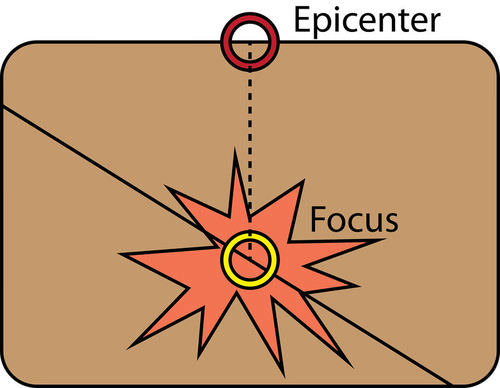6.7: Earthquakes
- Page ID
- 5407
What causes the greatest damage in an earthquake?
This photo shows the Mission District of San Francisco burning after the 1906 earthquake. The greatest damage in earthquakes is usually not from the ground shaking. The greatest damage is caused by the effects of that shaking. In this earthquake, the shaking broke the gas mains and the water pipes. When the gas caught fire, there was no way to put it out. Fire causes the greatest damage in many earthquakes.
Earthquake!
An earthquake is sudden ground movement. This movement is caused by the sudden release of the energy stored in rocks. An earthquake happens when so much stress builds up in the rocks that the rocks break. An earthquake’s energy is transmitted by seismic waves.
Causes of Earthquakes
Almost all earthquakes occur at plate boundaries. All types of plate boundaries have earthquakes. Convection within the Earth causes the plates to move. As the plates move, stresses build. When the stresses build too much, the rocks break. The break releases the energy that was stored in the rocks. The sudden release of energy is an earthquake. During an earthquake the rocks usually move several centimeters. Rarely, they may move as much as a few meters. Elastic rebound theory describes how earthquakes occur (Figure below).
Elastic rebound theory. Stresses build on both sides of a fault. The rocks deform plastically as seen in Time 2. When the stresses become too great, the rocks return to their original shape. To do this, the rocks move, as seen in Time 3. This movement releases energy, creating an earthquake.
Focus and Epicenter
The two important words used to describe an earthquake's location are focus and epicenter.
Focus
The point where the rock ruptures is the earthquake’s focus. The focus is below the Earth’s surface. A shallow earthquake has a focus less than 70 kilometers (45 miles). An intermediate-focus earthquake has a focus between 70 and 300 kilometers (45 to 200 miles). A deep-focus earthquake is greater than 300 kilometers (200 miles). About 75% of earthquakes have a focus in the top 10 to 15 kilometers (6 to 9 miles) of the crust. Shallow earthquakes cause the most damage. This is because the focus is near the Earth's surface, where people live.
Epicenter
The area directly above the focus, on the land surface, is the earthquake’s epicenter (Figure below). The towns or cities near the epicenter will be strongly affected by the earthquake.
The focus of an earthquake is where the ground breaks. The epicenter is the point at the surface just above the focus.
Summary
- A sudden release of energy stored in rocks causes an earthquake.
- The focus is where the rocks rupture. The epicenter is the point on the ground directly above the focus.
- Most earthquakes are shallow. Shallow earthquakes do the most damage.
Review
- Describe elastic rebound theory.
- Where is an earthquake's focus? Where is its epicenter?
- Why do shallow earthquakes cause the most damage?
Explore More
- What is it called when you feel the ground move?
- What does the Earth’s interior resemble? What is the outside layer called?
- What is Earth’s outer layer made of? What are they called?
- How fast does this outer layer move usually?
- What is a fault? How big are they?
- What happens when too much pressure builds up at a fault?




